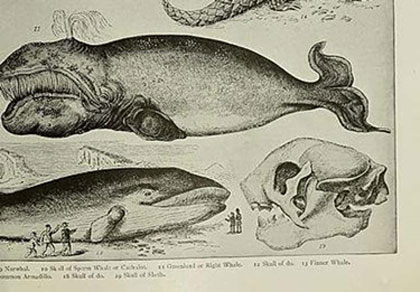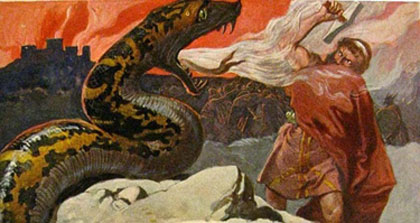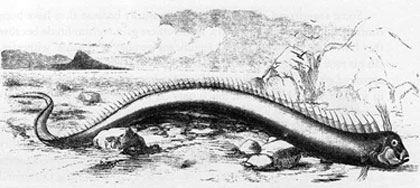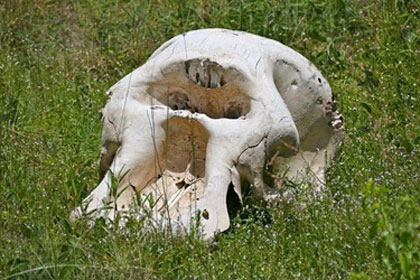
Surprisingly Plausible Real-Life Explanations For Mythical Creatures
Jodi Smith
Creatures like the narwhal, okapi, and Komodo dragon are on the short list of mythical creatures proven real. Yet, while scientifically interesting, these examples aren’t in the realm of more fanciful and legendary animals like unicorns, Bigfoot, or the more hilarious mythical creatures that cryptozoologists fawn over. Mythical creatures in real life often fail to live up to the expectations formed by old legends, fairy tales, or cartoons.
This is because real mythical creatures, like the proverbial “fish that got away,” generally grow larger and more bizarre in the telling. The oarfish, for instance, is a relatively harmless creature, but it’s easy to see how it inspired stories of giant sea serpents that capsize ships.
Science has provided plausible reasoning to explain away many of the legendary creatures peppered throughout the world. Several Reddit users and self-described historians have also theorized about the real creatures that were possibly misidentified and became the basis for cryptozoological legend.
________________________________________
• Herodotus’s Giant Flying Snakes May Have Been Whales From The Eocene Epoch
 Photo: Internet Archive Book Images / Wikimedia Commons / Public Domain
Photo: Internet Archive Book Images / Wikimedia Commons / Public Domain
From Redditor /u/hetep-di-isfet:
Archaeologist here. There’s a really interesting ancient Egyptian story called the “Shipwrecked Sailor,” in which a man is washed ashore on a beautiful island and apprehended briefly by an enormous serpent. In the story, the serpent tells him that there used to be hundreds of others like him but a falling star wiped them all out.
I think it’s unlikely that the Egyptians had knowledge of dinosaurs, but there’s a site called Wadi Hitan that has thousands of ancient whale skeletons from the Eocene. I think it’s possible they could have seen these skeletons and mistaken them for giant snakes. Herodotus actually tells similar tales of giant flying snakes in Egypt and, I suppose if you saw these skeletons but no trails, you might think they were capable of flight.
Did It Exist?
Wadi Al-Hitan, or “Whale Valley,” does exist, and it’s known for the giant whale fossils of the extinct archaeoceti located in its sands.
Although the flying snakes have no proof to back them up, the skeletons of the archaeoceti look very much like the remains of huge snakes due to the long spines without any whale-like characteristics attached to them.
It is highly possible that these whale fossils prompted the stories of the giant flying snakes, with the few flipper bones being misidentified as the creatures’ “wings.”
• A Meteorite In Estonia May Have Been The Midgard Serpent
 Photo: Emil Doepler / Wikimedia Commons / Public Domain
Photo: Emil Doepler / Wikimedia Commons / Public Domain
From Redditor /u/Daily_Dose13:
I’ve heard of a hypothesis that states the Ragnarok myth actually describes an impact event. The “Midgard snake” could be an object entering the atmosphere.
From Redditor /u/denshi:
There was a bronze age meteorite impact in Estonia that became a key element of Finnish mythology. Perhaps the myth percolated over to the Nordics.
Did It Exist?
It can never be proven unquestionably that the Kaali Meteorite Crater Field and the impacts that created it are the basis for the legendary Midgard snake plunging to Earth in an act of Ragnarok, but it is an excellent guess. More than 7,000 years ago, a meteorite plunged toward the Estonian island of Saaremaa, broke up in the atmosphere, and created several large impact sites in the area. The force of the chunks hitting land created a large, nuclear-level event that probably claimed several human lives, some wildlife, and destroyed anything else in their paths.
Groups without an understanding of meteorites or their ability to destroy in such an explosive way likely assigned meaning to the event in line with their exisitng belief systems. Thus the Midgard snake may actually refer to this huge and violent natural event that fits in with the Norse idea of the destruction of their gods and lands.
• The Oarfish Might Be Responsible For Ancient Legends Of Enormous Sea Serpents
 Photo: Harper’s Weekly / Wikimedia Commons / Public Domain
Photo: Harper’s Weekly / Wikimedia Commons / Public Domain
From Redditor /u/jamesianm:
I regularly get to see pods of humpback whales at the beach where I surf. Most of the time, all you see is their backs as they partially surface from the water. Occasionally, one of them breaches mouth-first, so you see a giant mouth emerge from the water. Other times, you see a giant tail emerge. If you were watching them and had no idea what a whale was, or that you were looking at multiple [whales], I could easily imagine mistaking multiple whale backs as the coils of a colossal snake. I strongly suspect that this is the origin of legends of sea serpents.
From Redditor /u/You_called_moi:
While that could be one origin, take a look at the oarfish. I think that might be the more likely origin, as it can grow to absolutely massive sizes. [Eleven meters is] the largest published length, with unconfirmed sightings of up to 17 [meters]…
Did It Exist?
While humpback whales partially surfacing may play a role in the mythic stories of sea serpents, the idea of the oarfish is more likely the creature responsible. According to National Geographic, oarfish can grow to be up to 30 feet long and live in the depths of the ocean, approaching the surface only when above average ocean currents push them there.
While the oarfish is blue and purple in its natural habitat, all those washed ashore or caught in fishermen nets are deceased or close to it, which gives them a dull silver appearance.
Furthermore, images of the oarfish are almost perfectly replicated in old drawings and descriptions of giant sea serpents, which include the long, spiny protrusions on their heads, fins, and spines.
• Mythical Creatures In Dreamtime Stories Could Be References To Extinct Megafauna
 Photo: Beclectic / Wikimedia Commons / CC BY 4.0
Photo: Beclectic / Wikimedia Commons / CC BY 4.0
From Redditor /u/Taleya:
You want the real gold standard… on this, you want Aboriginal tales from [the] Dreamtime (which in many cases have been proven to be validated records pre-dating the end of the last ice age). They co-existed with megafauna in Australia, and their crypto creatures have literally been linked back to now-extinct fauna.
Did It Exist?
“Dreamtime” refers to stories that explain Aboriginal beliefs about the spiritual and living worlds. These stories have existed for over 65,000 years, meaning some of the animals described in them could be about megafauna – large animals – that are now extinct. One of these animals is referred to as a bunyip, a creature living in swamps and other bodies of water in Australia that has a long neck, round head, and the body of a larger animal like an ox or manatee.
The diprotodon was named by a Professor Owen in 1838, and others wrote about the creature in their own journals while exploring the Australian region. The diprotodon, or giant wombat, lived in marshes, stood up to 6 feet tall, and is thought to have been last seen 65,000 years ago. This makes it one of several extinct megafauna that is likely featured in Dreamtime stories.
• The Mythological Roc May Have Been Inspired By The Elephant Bird Of Madagascar
 Photo: Charles Maurice Detmold / Wikimedia Commons / Public Domain
Photo: Charles Maurice Detmold / Wikimedia Commons / Public Domain
From Redditor /u/NerdGuy13:
A roc could have been real. It was most likely inspired by the elephant bird of Madagascar. An elephant bird was like a big-*ss ostrich about 9 feet high. They didn’t go extinct until the 16th or 17th century.
Did It Exist?
Scientists confirm that elephant birds roamed Madagascar as recently as the 1600s, as Admiral Ètienne de Flacourt’s Histoire de la Grande Isle de Madagascar describes the creature in detail with the name Vouronpatra. The birds stood 3 meters (9.8 feet) tall and weighed nearly 1,000 pounds.
Middle Eastern stories describe the Roc as a bird massive enough to carry off large mammals, like elephants or rhinos, in its talons. Marco Polo described the mythological bird as a native of Madagascar, making it even more likely that the Elephant Bird is the Roc referred to in legends
• Legends Of The Cyclops May Have Stemmed From Elephant Skulls
 Photo: Bernard DUPONT / Flickr / CC BY-SA 2.0
Photo: Bernard DUPONT / Flickr / CC BY-SA 2.0
From Redditor /u/Hattix:
The cyclops of Greek mythology. Go Google up an elephant skull. There’s this huge hole right in the middle of it looking to all the world like a single eye. Now add this to the knowledge that the Cretan dwarf mammoth left subfossil bones on Crete [that were] easily discoverable, [that the mammoth] was one meter at the shoulder, and [that it] could be more or less assembled into a giant humanoid.
Did It Exist?
Cyclopia is a real condition that causes a fetus to improperly split its eye cavities into two distinct areas, leading to one eye in the center of the head. This disorder is “incompatible with life,” triggering miscarriages and still births. Therefore, there are no cyclops in existence, leaving people to wonder about stories of large and seemingly adult cyclops in Roman and Greek mythology.
Some point to blacksmiths with eye patches as an origin story, but the idea of elephant skulls as the basis holds more weight. A dwarf elephant skull is closer to the size of a human’s than other, larger elephants, and may have prompted the idea of the cyclops as a humanoid.
Another theory proposes that those suffering from acromegaly disorder spurred tales of the cyclops. Acromegaly causes the size of a person’s hand, feet, and face to grow larger than normal, while obscuring some of their vision. This could make the one-eyed backstory more of a literary descriptor of the cyclops’ vision.
• The Pouakai Of Maori Legend May Have Been Haast’s Eagle
 Photo: John Megahan / Wikimedia Commons / CC BY 2.5
Photo: John Megahan / Wikimedia Commons / CC BY 2.5
From Redditor /u/AvatarTreeFiddy:
The Māori people of New Zealand have long told stories of the Pouakai, a monstrous bird that was big enough to hunt and eat humans.
Many believe that these stories are referring to the Haast’s Eagle. It was the largest species of eagle ever to have lived on Earth, weighed around 30 lbs, and had a wingspan of nearly 10 feet. It lived on New Zealand’s South Island and primarily hunted the flightless moa bird, which weighed around 500 lbs. Given the large size of its main prey, it’s likely that the eagle may have also targeted lone humans as well.
Interestingly enough, the Haast’s eagle went extinct around the year 1400, not long after the Māori arrived in New Zealand. It’s thought that its extinction can be attributed to habitat destruction combined with the extinction of the moa due to hunting by the Māori.
Did It Exist?
Pouakai and Haast’s Eagle are the same creature, according to scientists. With tiger-like claws and the ability to impact prey at up to 50 miles per hour, the eagle was large enough to intimidate and protect itself from humans approaching it. The bird was still alive and living in the forests when Maori arrived in New Zealand before going extinct between 1,000 and 1,400 years ago.
• Unicorns Were Likely Inspired By Ancient Travelers’ Accounts Of Rhinos
 Photo: Domenichino / Wikimedia Commons / Public Domain
Photo: Domenichino / Wikimedia Commons / Public Domain
From Redditor /u/HypersonicHarpist:
The mythical unicorn likely derives from travelers from Africa or Asia to Europe trying to describe a rhinoceros (there are Asian rhinos in India, Nepal, and Indonesia). When you consider that ancient Greek depictions of lions sometimes looked more like dogs and that the word hippopotamus comes from Greek words meaning “river horse,” it’s easy to see how a Greek traveler would describe a rhino as a one horned horse.
There’s linguistic evidence for this idea. Four-hundred years ago, it was believed that there were two types of rhinos. Ones with two horns were called “rhinoceros” and ones with a single horn were called “unicorn.” So the word unicorn was used to describe both real rhinos and the mythical one-horned horse. It wasn’t until zoology advanced as a science that “unicorn” came to refer purely to the mythical creature.
There are still remnants of the original usage, though. The genus of the scientific names for Asian rhinos (which have one horn) is unicornis.
Did It Exist?
The fairy tale version of a unicorn never existed in the real world, but the unicorn rhinoceros did. Thought to have shaggy fur and a single horn on its head, the Siberian unicorn lived in Eurasia until approximately 39,000 years ago.
This large herbivore roamed the wilds, and likely formed the basis of the majestic horse-with-one-horn depicted in mythological stories passed down for thousands of years.
• Yeti Sightings Can Probably Be Attributed To Bears
 Photo: Bob Bekian / Wikimedia Commons / CC BY-SA 2.0
Photo: Bob Bekian / Wikimedia Commons / CC BY-SA 2.0
From Redditor /u/drquakers:
The Yeti. Recently, they sequenced some DNA from so-called Yeti evidence [and] they pretty much all turned out to be bears – some extinct, some still around. To me, the most interesting one was the cross breed of the black bear and the polar bear.
Did It Exist?
Yetis are the version of Bigfoot that exist in the snowy mountains of places like Tibet or the Himalayas, but these legendary monsters are not real. They are indeed bears seen by terrified witnesses and verified by the DNA testing done on samples said to come from Yetis.
One of the samples even yielded results that came from a dog, further debunking the creatures’ existence.
• Steller’s Sea Ape Could Have Been A Malformed Otter
 Photo: Francis Henry Buzzacott / Wikimedia Commons / Public Domain
Photo: Francis Henry Buzzacott / Wikimedia Commons / Public Domain
From Redditor /u/benpaco:
Environmental scientist here to mention Steller’s Sea Ape. Steller is a highly respected name in botany, zoology, etc. to this day, responsible for naming and/or discovering a lot of charismatic Russian and Alaskan creatures such as Steller’s sea cow, Steller’s sea lion, sea otters, and many more. Everything he described was fully legitimate and confirmed despite concerns that he was making things up (iirc, people did not believe in a sea cow so large and docile as he described, or in otters at sea with thicker fur). There is only one exception, that being the sea ape.
This was a creature that he reported to be smaller than the men on the ship, furred, and ape-like, which swam around his ship in an almost mocking fashion, supposedly juggling and playing with kelp before dodging every bullet the crew shot at it and swimming off. Many different ideas exist as to what this actually was – some think Steller was mocking the captain of the ship – whom he had a contentious relationship with, referring to him as an “ape of the sea” – while others think that this may actually have been an edit put into Steller’s original works by a rival scientist. However, others still think that this may have been a real, observed incident with a malformed sea lion.
Personally, from what I have read, I think there is a decent chance that the sea ape was a unique animal, not an ape, but either a specific species or subspecies of otter, or other marine or semi aquatic mammal. Sea mink were likely still alive on the opposite coast of the [United] States at the time of this reported sighting – who’s to say that a larger, similar animal couldn’t have also frolicked through the waters of Alaska?
As for the “juggling,” I am no expert in German, but I know his original manuscripts were translated and then back translated before their initial publication (when the potential rivals could have inserted this story to harm his credibility), but my guess is the term for “tossing around playfully” and “juggling” are similar, and that the kelp may not have been actually tossed like a circus performance but rather spun around in the water playfully. Regardless, it doesn’t really make sense to me that one of the most respected names in science, known specifically for not telling the tall tales that his colleagues often did, would invent such a creature just to mock a coworker or gain fame. I don’t think this was really an ape, but I totally buy its existence.
Did It Exist?
According to Atlas Obscura, there are no recorded sightings of anything resembling Steller’s description of the sea ape. He said it had a dog’s head with long whiskers hanging down, pointed ears, large eyes, and a round, fat body that thinned out as it reached the tail end. Further, it had divided fins on the tail and dorsal areas, and the fur on its body was “red and cow-colored.” Steller did not seem to believe the animal was sickly, describing it instead as playful.
While on expedition to Alaska, Steller shared a ship with a captain he disliked immensely, and he suffered from scurvy before reaching their intended landfall. Many still believe the sea ape was a jape at the captain, with the description of facial hair matching that of Captain Vitus Bering. The idea of a disfigured sea otter is also thrown around, but there is not a consensus for this resolution, since the creature was not identified as being sickly. Steller discovered his sea otter while on the same trip, making one wonder why he would not recognize the same creature with deformities.
This mythical creature remains unidentified to this day, though Norwegian zoologist Leonhard Stejneger argues that Steller’s report of the creature aptly describes a fur seal.
• Vampires Likely Emerged From The Treatment Of Rabies Victims
 Photo: Nosferatu/Film Arts Guild
Photo: Nosferatu/Film Arts Guild
From Redditor /u/LameOCallahan:
There are many diseases that the origin of the “Vampire/Vampyr” myth can be traced back to; however, I think rabies fits it the most.
In the olden days, people would tie those suspected of it to trees. In about three days’ time, the disease would drastically change them.
Extreme light sensitivity, paleness, aggression, excessive drooling. They could/would try to attack you and have bouts of either extreme slow fatigue or even adrenaline.
Did It Exist?
Vampires have many inspirations that formed them into the creatures known today in books, television, and movies. The basis for Bram Stoker’s Dracula supposedly came from the bloodthirsty Vlad the Impaler, but what about the stories of the nocturnal creature that predate the 1897 novel? Rabies may very well hold the key to the origin of vampires, debunking their existence while explaining their creation.
In the 1700s, vampires were a topic of fear and discussion, overlapping with a rabies outbreak in Hungary. According to Medical News Today, multiple characteristics of the disease and the creature match up. Vampires are generally male, matching up with the increased incidence of rabies in the male population. Rabies causes hypersexuality and a strong objection to strong odors, mirrors, and light. All of these are characteristics of vampires in popular culture, with a dislike of garlic, favoring the night, and avoiding mirrors. Rabies can also cause people to suffer insomnia and prompt them to wander around during the time when others are sleeping.
• Changelings Were Probably Children With Autism Or Other Disorders
 Photo: Henry Fuseli / Wikimedia Commons / Public Domain
Photo: Henry Fuseli / Wikimedia Commons / Public Domain
From Redditor /u/rockeh:
I had read somewhere that changelings usually had Angelman syndrome, which gives an elfin appearance, a happy attitude, a fascination with water, and severe mental retardation.
From Redditor/u/TheMightyGoatman:
Children with autism seem to develop normally for 12 to 18 months, then suddenly change and become much more withdrawn and uncommunicative. You could easily believe that your kid had been stolen by the fairies and an imposter left in their place.
Did It Exist?
Tales of changelings involve fairies taking human children and leaving one of their own behind, with the parents soon noticing their baby has become unemotional, mute, unresponsive, or otherwise changed from their previous personality. Autism symptoms develop around the ages of a few months to 2 years old, matching up with the ages in Changeling folklore. Many scientific studies theorize that the myths came from people without knowledge of the disorder creating a reason for the changes in their child.
Another possibility for these stories is the birth of a child with Down’s Syndrome or other disabilities or diseases that change their appearance from that of other babies or children in the family.
• Bigfoot Stories Are Probably Interactions With Malformed Bears Or Ancient Apes
 Photo: Bob Doran / Flickr / CC BY 2.0
Photo: Bob Doran / Flickr / CC BY 2.0
From Redditor /u/PunchBeard:
I believe that Bigfoot probably does exist. Or at least did until very recently. But… I doubt that it was a unique species. My theory is that what people see is a mundane animal, probably a large brown bear, with serious genetic deformities.
Encountering a 7 foot bear with mange, maybe a deformed cranium, possible scars from fights with other bears, and other such traits would certainly trigger a “fight or flight” response. You see something like that [and] you haul *ss in the other direction. When you stop, you’re not 100% certain of what you saw, so your brain fills in the details. So, you take a deformed animal and mix it with an imaginative mind that knows what the popular version of Bigfoot looks like, and you get a bonafide Bigfoot sighting.
Did It Exist?
In 2016, National Geographic shared the story of an American black bear that injured his front legs and adapted to walk upright. Known as Pedals, the bear thrived with its new mode of getting around, and proved that the animals can adapt to injuries. Pedals also earned a comparison to Bigfoot for his method of transportation, making it not outside the realm of possibility that other bears have adapted in the same way and perpetuated the myth of Sasquatch.
While no evidence exists to support Bigfoot as a reality, the DNA sequencing done to his snowy cousin the Yeti points to a bear as well. If bears are responsible for the sightings in the Himalayas, then bears in wooded areas of America are likely the real culprits behind sightings of Bigfoot – especially with Pedals showing that they can adapt to walk upright on a permanent basis. Add in diseases such as mange, which causes patches of fur to fall out, and the descriptions of the mythical creature become grounded in reality.
• The Chullachaqui Of The Amazon Might Be Leafcutter Ants
 Photo: SabineDeviche / Wikimedia Commons / CC BY-SA 4.0
Photo: SabineDeviche / Wikimedia Commons / CC BY-SA 4.0
From Redditor /u/7LeagueBoots:
When I was working in the Amazon, I was told of a creature called a Chullanchaqui. They make gardens in the forest, generally of all one species of plant, and if you encounter them you are supposed to walk around them. If you must pass through, you ask permission, walk through quickly, and don’t touch anything. If you don’t obey this, the Chullanchaqui will attack you.
Well, those forest gardens are the large hives of leaf-cutter ants, and if you spend any time inside them or disturb the vegetation in them, the ants will come out and attack you.
Did It Exist?
Chullachaqui is supposedly a gnome guardian of the Amazon rainforests that can take on the shape of other people to lead victims deep into the forests. He has one foot larger than the other and guards the medicinal Chullachaquicaspi tree, ambushing those that destroy vegetation.
Clearly, the Chullachaqui does not exist, but leafcutter ants help protect and propagate the rainforests that they live in by shearing back plants and moving soil. They do accost any predators that disturb their colony or work, but that doesn’t account for the idea of a shape-shifting creature luring folks deep into the forest or assisting them to safety if they treat the rainforests with respect.
The seemingly invisible retaliation may come from the ants, but the shape-shifting remains unexplained and mythic.
• The Terrifying Questing Beast From Arthurian Legend Is Probably A Giraffe
 Photo: Charles J. Sharp / Wikimedia Commons / CC-BY-SA 4.0
Photo: Charles J. Sharp / Wikimedia Commons / CC-BY-SA 4.0
From Redditor /u/DuploJamaal:
In Medieval Europe there were unbelievable stories of animals from Africa that were huge, had a head like a snake, a body like a leopard, the haunches of a lion and hooves like a hart. They became the mythological Questing Beast from the King Arthur folklore.
Well, they were just Giraffes.
Did it exist?
The Questing Beast, or the Beste Glisant (barking beast) in the French version of the Arthurian legends, was a fearsome beast that was described in a 13th century translation of Tristan and Isolde as having a stag’s feet, a serpent’s head, a leopard’s body, and a lion’s thighs and tail, along with making a haunting “questing” noise – a term which not only is an old word for “barking” or “baying,” but gives a solid pun in the creature’s purpose as well.
The first encounter of a giraffe in Western record sounds remarkably similar to the questing beast – when Julius Caesar first brought one to Rome from Africa, it was called a “camelopard” and believed to be a combination of the two animals with a startlingly long neck. And, looking at a giraffe today, we can see the cloven hooves, the serpantine neck, and even the lionesque tail that would have seemed fantastical to people living in medieval England. As for the barking, giraffes do make some pretty weird noises that would be spooky to hear in the wild.
ranker.com























